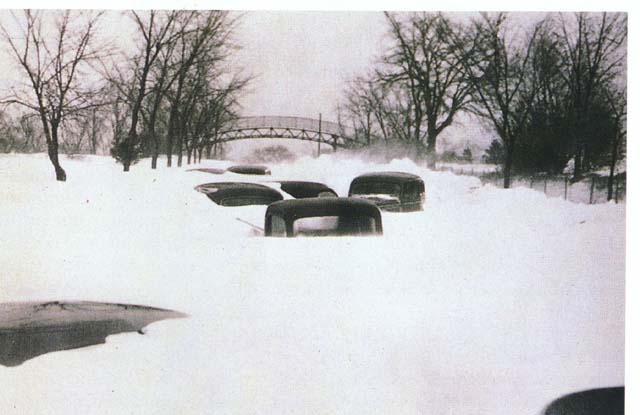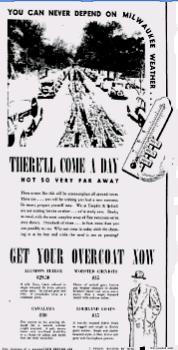
Armistice Day Blizzard, Excelsior Blvd., West of Minneapolis. Minn. Historical Society photo, NOAA.
For many, the eleventh day of November is remembered as Armistice Day or Veterans’ Day. In Minnesota and much of the Midwest, it’s also remembered as the date of the Armistice Day Blizzard of November 11-12, 1940.
The storm came up quickly and was responsible for 145 deaths, including 49 in Minnesota. About half of those 49 were duck hunters who froze to death, unable to escape the sudden storm.
 The severity of the storm was largely unpredicted. The newspaper forecast in the Milwaukee Sentinel was typical of that appearing in Midwestern papers. It called for “cloudy with occasional rain in south and rain or snow north; colder Monday (the 11th); Tuesday (the 12th) cloudy, possibly snow flurries and colder.” Ironically, that paper included the advertisement shown here for overcoats, warning, “you can never depend on Milwaukee weather,” and “there’ll come a day, not so very far away, when scenes like this will be commonplace all around town.”
The severity of the storm was largely unpredicted. The newspaper forecast in the Milwaukee Sentinel was typical of that appearing in Midwestern papers. It called for “cloudy with occasional rain in south and rain or snow north; colder Monday (the 11th); Tuesday (the 12th) cloudy, possibly snow flurries and colder.” Ironically, that paper included the advertisement shown here for overcoats, warning, “you can never depend on Milwaukee weather,” and “there’ll come a day, not so very far away, when scenes like this will be commonplace all around town.”
Those scenes came to the Midwest much faster than anyone expected. Within hours, temperatures were dropping, massive amounts of snow fell, and winds caused peril to those on both land and water.
The storm disrupted communications through much of the region, as telephone and telegraph lines were taken down by the fierce winds. As might be expected, Amateur Radio operators stepped in to fill the need, as reported in QST for January, 1941. Hams provided communication to the railroads, the Red Cross, and especially for private citizens, since broadcast stations broadcast the telephone numbers of local hams who could relay messages to towns cut off by the storm. Minneapolis Ham George H. King, W9OTE, reported that his phone rang constantly with requests from worried families, with his wife unable to prepare dinner because of the constant calls.
A couple of familiar names appear in the QST article. The first was Stanley L. Burghardt, W9BJV, of Watertown, S.D., who contacted the families of dozens of Watertown residents who were stranded in Minneapolis. Burghardt’s call later became W0IT, and is famous among Hams as the owner of Burghardt’s Amateur Center in Watertown. Burghardt’s antenna collapsed in the blinding gale, forcing him to go outside to effect a repair that held until the storm ended.
Another familiar name in this story was that of Sherman Booen, then of Albert Lea, MN, W9HRT. He reported that most of the wire facilities in Albert Lea had been wiped out, and he reported that 75 meters was a beehive of activity. He reported that he went to bed, but at 10:30 PM, a railroad dispatcher in Albert Lea called him. The dispatcher had been unable to contact his chief in Minneapolis, and needed to get through for permission to start a snowplow north. Booen was able to get that message through in ten minutes. A total of 15 railroad messages were relayed by Booen.
The name Sherman Booen is familiar to many Minnesotans. After the war, his call sign became W0RHT, and he was a well-known Ham. He was also an aviator and broadcaster, and best known as the host for 28 years of “World of Aviation” on WCCO-TV in Minneapolis. He passed away in 2011 at the age of 97, having been licensed as a Ham since 1934.
Read More at Amazon

Pingback: Japanese Fu-Go Fire Balloons of WW2: Part 4 | OneTubeRadio.com
Pingback: Armistice Day Blizzard 75th Anniversary | OneTubeRadio.com